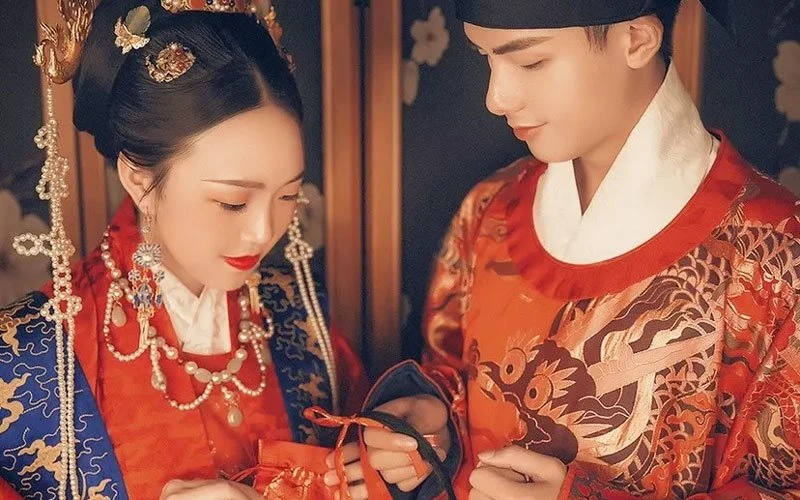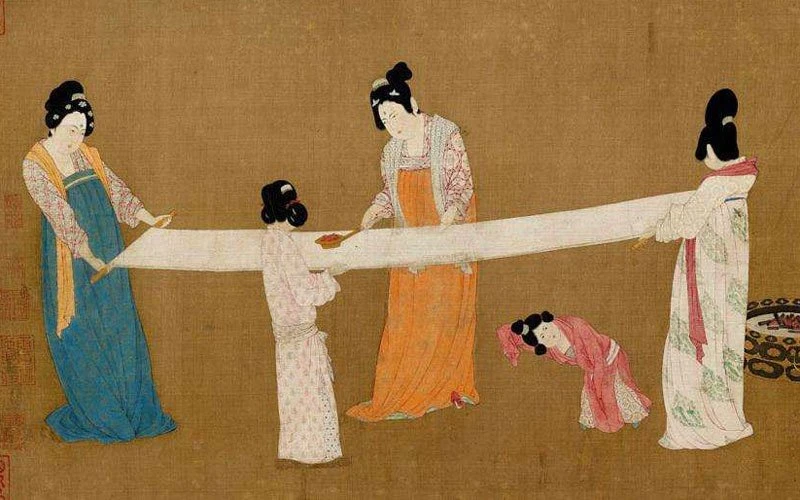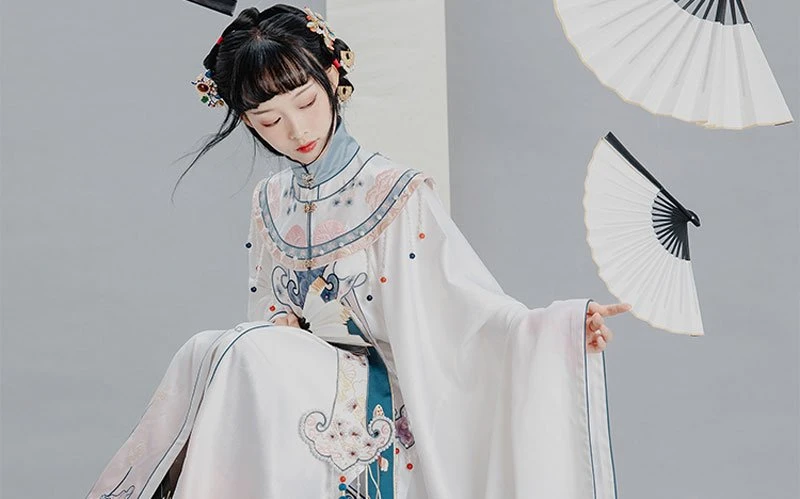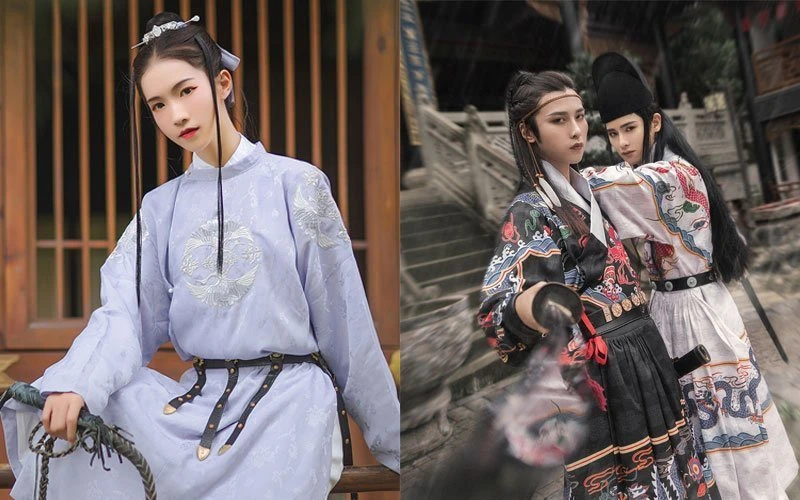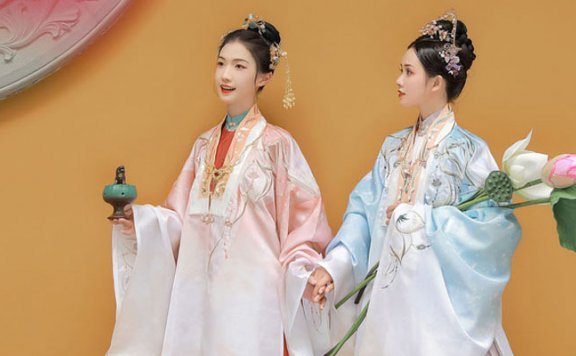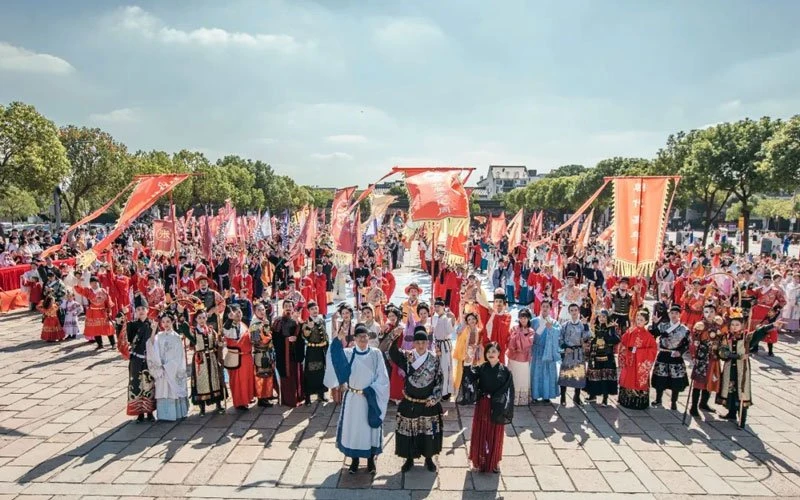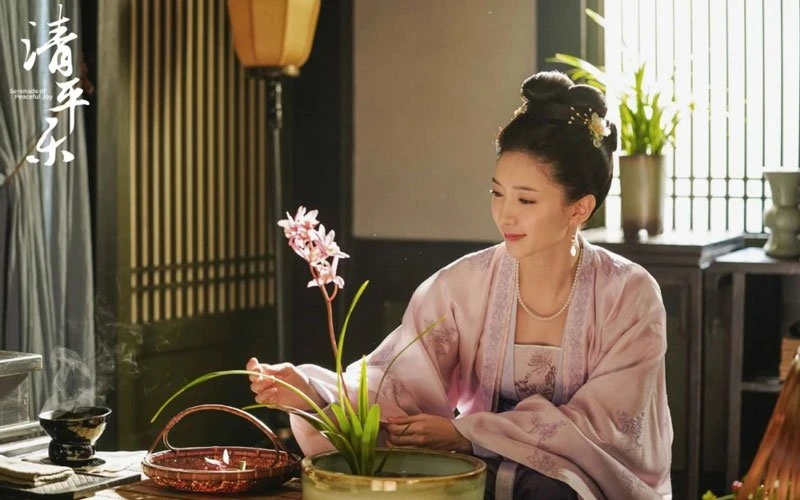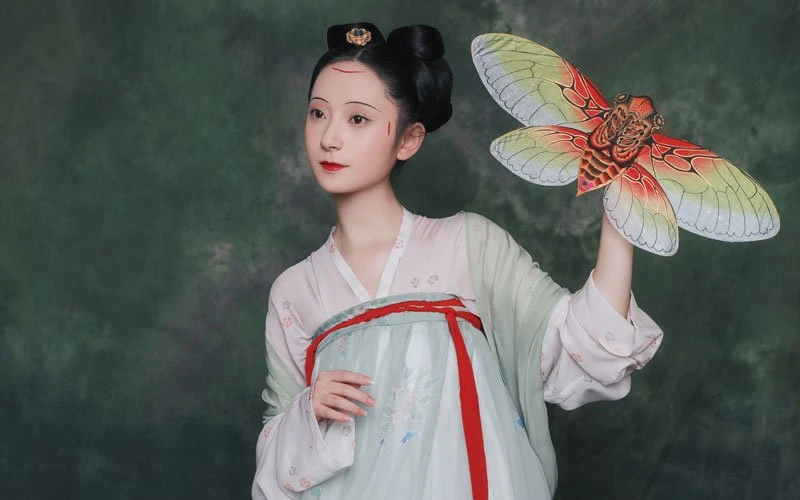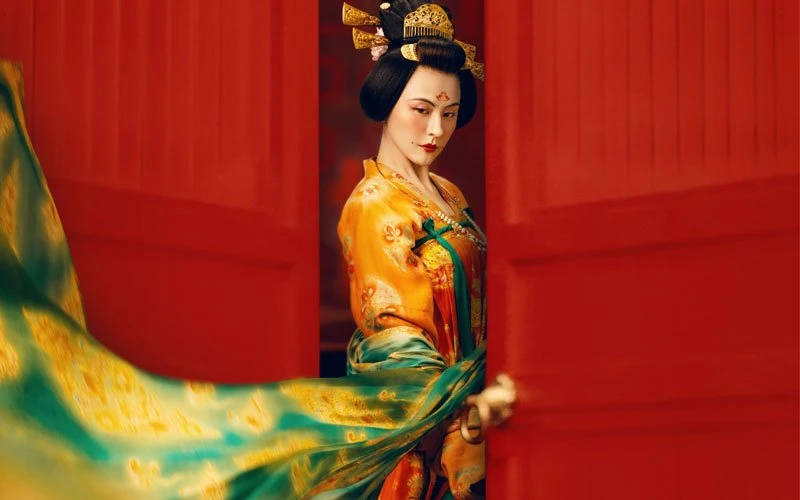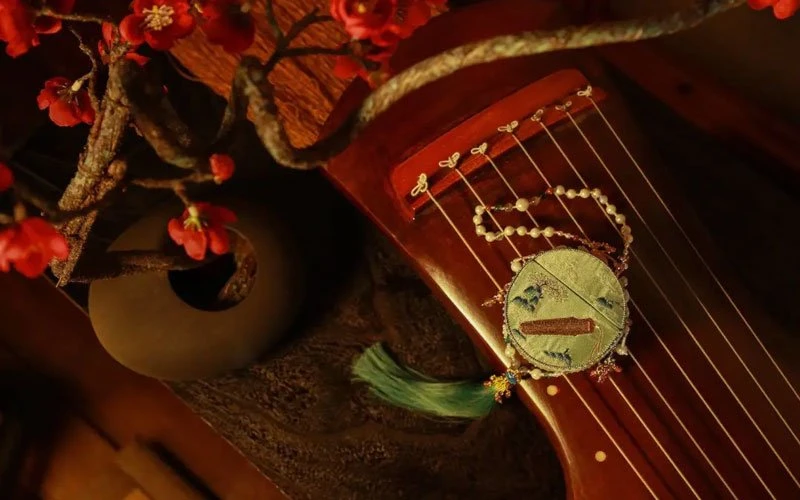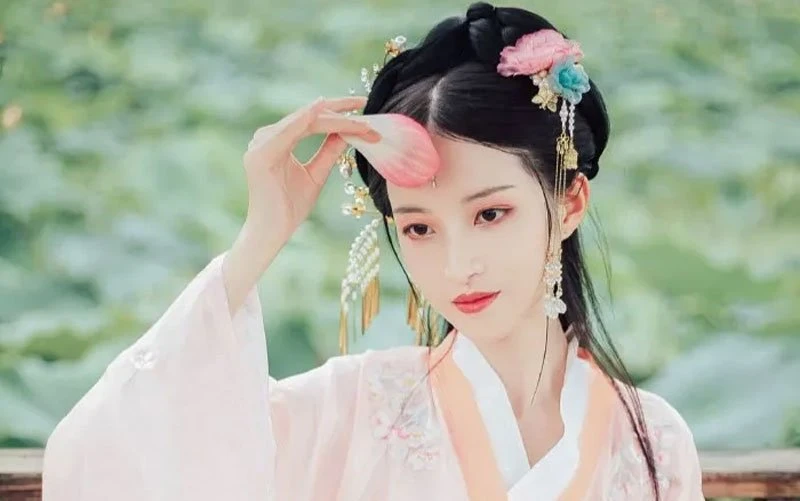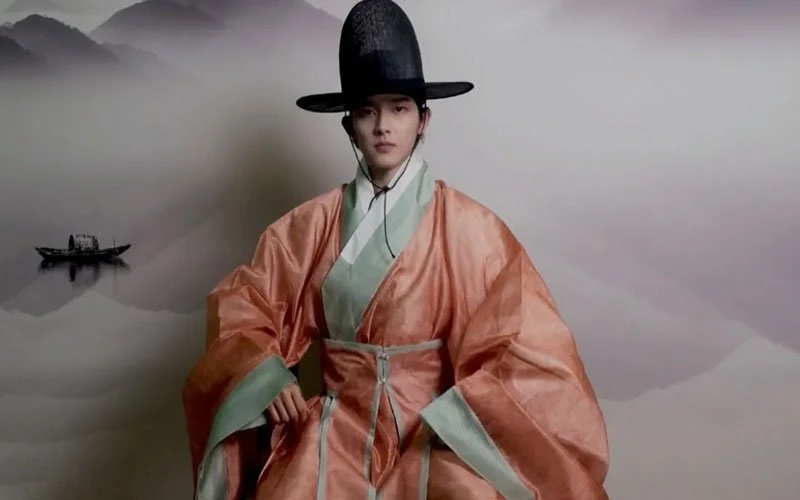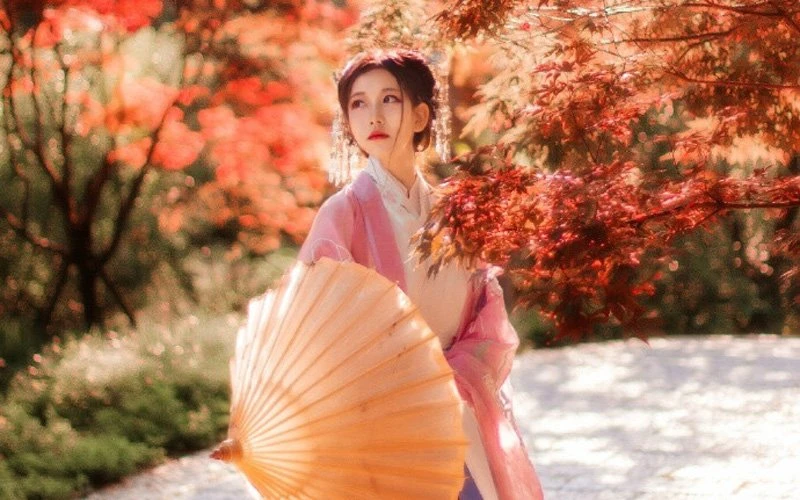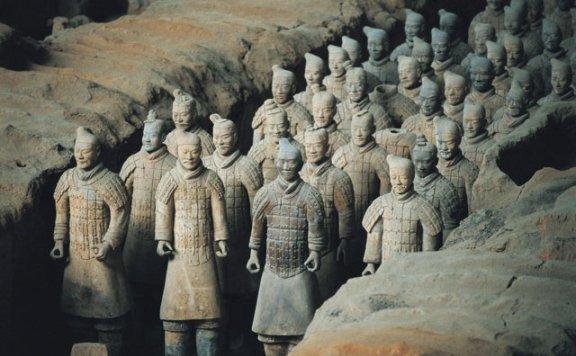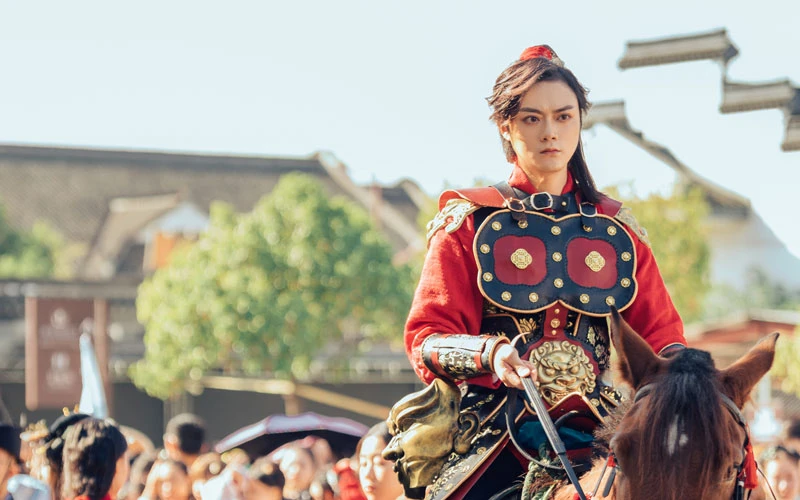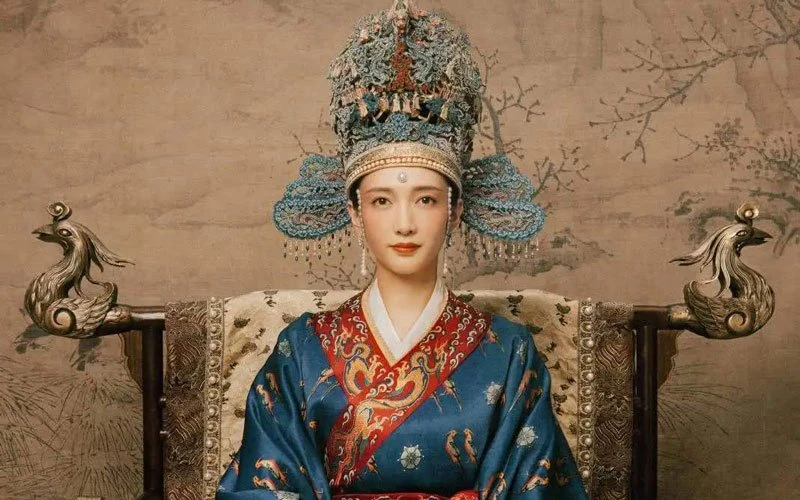Article
搜索结果:
-
Hairstyle Tutorial for Traditional Chinese Hanfu Dress - 2
Today we have brought you a new Hanfu hairstyle course. It's more complicated, but it's very nice. Tools to be prepared 1. bull horn wig package *2, adequate hair can be used unnecessarily (牛角假发包) 2. 10*70cm wig piece *2, adequate hair can be used unnecessarily (假发片) 3. hairnet *3 (发网) 4. elastic *N (based on the actual determination) 5. hairpin *N (based on the actual determination) Detailed steps 1. Put up the back hair first and tie it high. 2. Two bull horn wig packages are fixed on both sides. 3. Pull out a little strand of hair and comb the rest back. Fixed after covering the wig package ~ Both sides are the same. 4. Fix the hair tied in the first step on the top of the head. 5. Fix the tail of the bangs around the top of the head. 6. Hair netting, sheathing, and fixing. 7. Use the wig piece. Cover the body's hair and fix it. 8. Fix another piece of the wig on the top of your head in reverse. 9. Fix the hairnet at the wig joint with a hairpin. 10. Half of the wig is put into the hairnet. 11. Then start… -
Introduction of Chinese Traditional Hanfu Wedding
Hanfu wedding, which is wearing traditional Chinese clothing: Hanfu, and taking the traditional Chinese wedding system as the prototype. Modern people restore the traditional Chinese wedding, they roughly sum it up as follows The Zhou Hanfu wedding (周制婚礼), represented by the pre-Qin and Han Dynasties. Tang Hanfu wedding (唐制婚礼) represented by Wei, Jin, and Tang Dynasties. Ming Hanfu wedding (明制婚礼) represented by song and Ming Dynasties. The traditional Chinese Hanfu wedding ceremony is generally divided into three parts: pre-wedding ceremony, formal wedding ceremony, and post-wedding ceremony. As we all know, culture is the life of a nation, and etiquette is one of the main signs of all civilized nations and an important window of national culture. As the Chinese nation with a long civilization of 5000 years, attach great importance to marriage. The book of Zhouyi said: Only when there are heaven and earth can there be everything. Only when there is everything can there be men and women. Only when there are men and women can there be couples. Only when there are couples can there be fathers and sons. Only when there are fathers and sons can there be princes and ministers. Only when there are princes and… -
How did the Ancients Chinese Iron Hanfu
Iron is a common small appliance in modern homes, and almost every home has one, but did you know that irons have been in use since 2000 years ago, or even earlier? How did the ancients iron Hanfu? The Origin of the Ancient Iron The origin of the name "Yundou (熨斗, iron)" is that its image is similar to that of "Big Dipper", and secondly, the shape of the Yundou is like the China ancient cooking utensil "Dou (斗)". In ancient China, the Yundou, also known as "fire Dou", "gold Dou (an iron made of gilding technology, it is not a general folk good)", "Gumu (钴鉧)", its main function is to iron Hanfu clothes, the effect is two: one is to iron out any wrinkled areas of clothing, another effect is to iron the pleats, at where need to be visibly pleated. The first iron was made of stones, pottery, or copper, roasting on the fire, and then pressed on the clothes to iron them. It is said that iron was invented before the end of the Shang Dynasty. King Zhou of the Shang Dynasty was inspired by the fact that irons burned people's hands when they were used,… -
History of Chinese Silk Robe & Han Dynasty Textile Industry
Silk is one of the symbols of Chinese civilization, China due to the abundance of silk, has been named the "Silk Country" known, the use of silk is also with the development of the times are also changing, from the initial production of clothing, to later become a popular commodity and to some extent, instead of currency, all of these changes have highlighted its unique status. Today begins through a precious Chinese silk robe, discover how the Han dynasty textile industry developed in ancient China. Precious Chinese silk robe: Sucha Danyi In the winter of 1951, while conducting archaeological work in Changsha, archaeologists discovered two connected grave at Wulipai in the eastern suburbs of Changsha. After several difficult excavations until 1974, the Mawangdui Han tombs, which had been dormant for thousands of years, was unveiled. Among the many precious artifacts unearthed, the most notable is the Zhiju Susha Danyi (直裾素纱襌衣, plain yarn garment). "Thin as a cicada's wing, light as floating smoke", this Chinese silk robe was especially valuable because it was 128cm long, with 190cm sleeves, but weighed a mere 49 grams and could even fit in a matchbox when folded. It was hailed by archaeologists as a milestone… -
12 Latest Fashion Chinese Clothing Hanfu Styles in Runway
The last month has seen a very large number of Hanfu events, as well as the release of very many new Hanfu styles, especially those featured in the fashion runway shows. Hanfu styles that make it to the show are of high quality in terms of fabric, fit, and design. We've selected some of the most stunning styles from the recent shows, let's take a look at the latest Chinese clothing Hanfu style! Tang-style Hezi Qun & Daxiu Shan The hottest item on the show recently has to be the Tang style Hezi Qun (诃子裙, skirt ) in the picture of the beauty in tears. It not only looks full of senior, with gorgeous accessories as if back to the Tang Dynasty. The classic color matching, wear a full texture. Ginkgo Cat Winter Jiayi & Bijia Winter is getting closer and closer, and a nice winter Jiayi (夹衣) is sure to capture your heart in no time. A cute cat rolling around under a ginkgo tree on an autumnal day is a beautiful sight to behold in this autumnal orange Jiayi. The sleeves are adorned with a lovely lace border and the cuffs are decorated with little round pompoms. Whoever… -
Hanfu History | The Development of Chinese Robe System
We often see many different Chinese robe styles of Hanfu, but you may not be able to say exactly what the difference is between them. There are many similarities in different styles of Hanfu, but with the development of history, it is gradually optimized, convenient to wear, and also derived from different shapes. This article will introduce the form system of the Hanfu and Chinese robe system. The form system of Hanfu There are many styles of Hanfu, but they can be divided into the following shapes, Yichang system (衣裳制), is the kind with the separation of the upper and the lower garments. Shenyi system (深衣制), is the one-piece kind that unites the upper and the lower garments together, make separately, and sew together. Paofu system (Chinese robe, 袍服制), cut out the upper and the lower garments with a piece of cloth, no seam in the middle, natural integration. The uniform system of Chinese robe (袍服) Chinese robes appeared in the pre-Qin period, at that time, were just underwear with cotton, so people have to wear it with their coats. In the Zhou Dynasty, emperors used robes for daily wear. In the Qin and Han Dynasties, the status of robe… -
Guide to Traditional Chinese Clothing - Hanfu
Hanfu (汉服, hàn fú), Chinese traditional costume, the full name of which is "traditional costume of Han nationality". It is also known as Han Yiguan(汉衣冠), Han Zhuang (汉装), and Huafu (华服), which was formed from the reign of the Yellow Emperor to the middle of the 17th century (late Ming and early Qing dynasties), in the main residential areas of the Han nationality, with "Huaxia-Han" culture as the background and the dominant idea. With the Chinese ceremonial culture as the center, through natural evolution, formed the unique style and character of the Han nationality, obviously different from the traditional clothing and accessories system of other nationalities. This guide is classified according to the 1: basic feature of the Hanfu, 2: Hanfu shape & style, 3: Hanfu in different wearing scenes, 4: Hanfu in different dynasties, and the 5: related contents of Hanfu, so as to facilitate readers to understand and query. Basic Feature of the Hanfu 1.1: Basic Structure Hanfu is cut from 50cm wide cloth and divided into parts: Ling (领, lǐng, collar), Jin(襟, jīn, placket), Ren (衽, rèn, overlapping part), Jin (衿, jīn or jìn), Ju (裾, jū), Xiu (袖, xiù, sleeves), Mei (袂, mèi), Dai (带, dài,… -
Grand Opening of the 8th Xitang Hanfu Culture Week
In the bustling crowd, women in Hanfu, men in armor, passing by. This beautiful dream, has been realized in Xitang. October 31, the eighth Chinese national costume show and China Xitang Hanfu culture week in Zhejiang Xitang ancient town grand opening, from all over the country tens of thousands of traditional culture lovers and tourists gathered in Xitang, to watch the national costume show, to promote traditional Hanfu culture, to enjoy the scenery of Xitang. https://youtu.be/mw0kOrUPHpQ ▲Video of the opening ceremony of the 8th Xitang Hanfu Culture Week Let's take a look at the highlights of this year's Xitang Hanfu Culture Week Carnival by following the Xitang Travel. First up was the carnival float. The float beats the drum to symbolize the pioneering spirit of Wu Zixu. The float extracts the elements of the ancient architecture of Xitang in the Ming and Qing dynasties, combines the humanistic atmosphere of "poetry and painting" with the traditional calligraphy and painting, and is designed from the Yongning Bridge, the symbol of Xitang ancient town, which conveys people's beautiful vision of "eternal peace and prosperity", and creates a "poetic and picturesque" "dream Xitang" cultural visual feast. Followed by the honor guard, riding… -
The Beauty of Ancient Song Dynasty Costumes in Qingpingyue
This year's large-scale costume Chinese historical drama Serenade of Peaceful Joy (清平乐, Qingpingyue) has attracted a lot of attention from the production team, plot settings, cast, costumes, props, and set pieces. The drama has highly restored various scenes of Song dynasty life and characters, creating an ancient simplicity and elegance, which takes the audience back to the time of the prosperous Song dynasty. Today, let's revisit "Serenade of Peaceful Joy", starting with the ancient Song dynasty costumes, and experience the beauty and comfort of the Song Dynasty once again. Experience the beauty of ancient Song Dynasty costumes Historical elements can be seen in the costumes, makeup, and props in the drama "Qing Ping Le". From the emperor’s clothing of Song Renzong, Zhao Zhen (赵祯, played by Wang Kai) at the grand court meeting, to the exquisite headdress and makeup of Empress, Cao Danshu (曹丹姝, played by Jiang Shu Ying) at her wedding, everything is very elaborate and almost 1:1 restored with the historical portrait of Song Dynasty. The two special ancient Song dynasty costumes mentioned in the drama, let us also get to know them today. Gunfu (衮服, gǔn fú) In the drama, in the last year of the Empress Dowager Liu… -
History of Tang Dynasty Makeup Style
The Tang dynasty makeup style can almost be said to be the most versatile in the entire ancient history of China, because both in terms of national power and politics, the Tang dynasty almost reached the pinnacle of history, and because of this prosperity, the makeup of the women's makeup in the people's peace of environment constantly changing refinement. With the transformation of the early Tang Dynasty, the flourishing Tang Dynasty, and the middle and late Tang Dynasty, the makeup was also making different changes, and for this reason, some special makeups were created, as we can see from the many ancient wall paintings and drawings. Early Tang Dynasty makeup style: the beauty of simplicity In the early Tang Dynasty, influenced by the short-lived Sui Dynasty (581-617), the royal family did not pursue luxury and advocated simplicity. Therefore, the overall makeup of the women's more subtle and graceful, to lightly coated with lead white makeup and lightly coated with rouge red makeup mainly. | White Makeup | Since ancient times, people have advocated the beauty of white, so women have the custom of powder, only to the Tang Dynasty, women's powder and style more diverse and prevalent. During the… -
Explore Classic Female HanFu from Chinese Historical Dramas
Over the years there has been a rise in the revival of Hanfu clothing, and more and more people are trying to wear it. Perhaps the first reaction to the mention of Hanfu will be that it is the clothing of the Han Dynasty, but in fact, Hanfu does not refer to Han Dynasty clothing alone, Hanfu is the short form of traditional Han national costume. In the thousands of years of history, it has carried the aesthetics of Chinese people's life, showing classical, subtle, light, and elegant to the fullest. There are more and more channels for us to learn about Hanfu, but I believe that many people were first introduced to Hanfu in Chinese historical dramas or movies. In recent years, the costumes and props in dramas and movies have become more and more exquisite, and many people have become interested in Hanfu in the process of watching the dramas. Today, we will get to know the classic female Hanfu costumes from the Tang, Song, and Ming periods through stills from several classic Chinese historical dramas. There are two types of Hanfu: (礼服, formal dress) and Changfu (常服, daily dress). The Lifu is worn on important occasions such… -
History of Chinese Traditional Earrings
Chinese Traditional earrings are of various types, both decorative and ceremonial, and have been an indispensable part of people's decorations since ancient times. The popularity of Chinese Traditional Earrings The first appearance of earrings can be traced back to the Neolithic period. At that time, people's craftsmanship was limited to a certain extent, so earrings were usually in the shape of simple rings with notches and were called "Jue (玦)", mostly made of jade, but also bone, stone, agate, and ivory. Later, with the development of dynasties and civilizations, earrings became richer in style, with different styles such as earrings, earrings pendants, and so on. However, earrings have not always been a symbol of beauty in a long history. In ancient China, women's status was far inferior to men's, so people came up with the idea of piercing holes in women's ears and hanging earrings to remind them to act cautiously, in order to restrain their behavior. In the olden days, until a girl was 10 years old, her mother or other elders would repeatedly be grinding with rice grains over the girl's earlobe to numb it, then pierce it with the tip of a needle, and then wear a piece… -
The History of Chinese Traditional Scented Sachet
Chinese incense culture has a long history. As an important part of incense culture - Chinese traditional scented sachet culture, it also carries a large amount of cultural information, reflecting the aesthetic concepts and social customs of people in different periods, as well as the achievements of Chinese textiles and fine manufacturing. Nowadays, due to the emergence and use of aromatherapy, perfume, and other items, incense sachets have rarely been used except on specific festivals and occasions, but they have left a strong mark in the history of incense used in China. The History of the Traditional Sachet Scented sachet (香囊, Xiangnang) is a folk embroidered craft created by ancient women, originally developed from Peinang (佩囊), a small cloth pocket used by the ancients to hold small objects. There were no pockets on the clothes of the ancients, so some portable necessities, such as seals, hand towels, coins, etc., were stored in this kind of pouch, and when they went out, they put it on their waist, so it was called "Peinang". Scented sachet belongs to a kind of Peinang, which is named after the spices stored in the sac. According to the literature, the history of wearing scented… -
Chinese Historical fashion Items for Tang Dynasty Women
As we all know, the Tang Dynasty had unprecedented national power, strong economic strength, people lived in peace and happiness, and the people's pursuit of fashion is also increasing. Today for you to introduce the women fashion items in the Tang Dynasty, let's take a look at Chinese historical fashion together. The Essential Diexie Belt (蹀躞带) for Tang Dynasty Women The movie "The Assassin" released in 2015, in which the female protagonist Nie Yinniang is dressed in a black robe, wearing a very fashionable belt at the waist, which is a popular "Diexie belt" in the Tang Dynasty. Diexie belt was originally a kind of waist belt of the Hu people, since the Wei and Jin Dynasty, introduced into the Central Plains, to the Tang Dynasty was once set as civil and military officials must wear something. An antique Tang dynasty Diexie belt, now in the Shaanxi Provincial Institute of Archaeology. It is 1.5 meters long and 1.2 centimeters thick and is made of white jade, some of which is light green. The jade belt is made of using traditional decorative techniques, inlaid gold in Hetian white jade, and the quality of the jade is warm, luxurious, and beautiful.… -
3 Basic Elements of Classical Hanfu Makeup
Hanfu makeup often plays a pivotal role in the dressing of Chinese costumes. In ancient times, each dynasty had a different style of makeup, although it is difficult to master all of them, just need to find a style that suits you, and master the key elements of the Hanfu makeup, will show better results. Eyebrows The eyebrows are a very important part of Hanfu makeup, and ancient women had a wide variety of eyebrow shapes, such as the Tang Dynasty, which had more than ten classic eyebrow shapes. The shape of your eyebrows needs to be determined by the style of Hanfu you are wearing, if you are wearing Ming Dynasty Hanfu, the most recommended eyebrows are Daiyu eyebrows (黛玉眉), which are very slender and delicate, like a wisp of smoke hanging in the air, dignified and gentle. If you choose the Qixiong Ruqun, you can choose the Yueleng eyebrow (月棱眉), which was popular in the Tang Dynasty. The tip of the Yueleng eyebrow is thin, and the waist of the eyebrow is wide and thick, curving like a hook, like the winding of the month. You can also try Daji eyebrow (妲己眉), which will be more charming.… -
Chinese Traditional Costume - Ming Style Daofu for Male
Previously we have discussed the Ming Dynasty men's clothing: Zhiduo (直裰), Zhishen (直身), and Taoist robe (道袍). And today we are going to discuss the Daofu. Daofu (道服, Dào fú) has two meanings in Chinese: refers to Taoist clothing, the robes worn outside by Taoists; one of the Chinese traditional costume Hanfu styles: Ming Dynasty costume for males. Obviously, they are different kinds of clothes, today, let's learn about the traditional sense of "Daofu" through the Hanfu Culture Society! [Structure and History] Daofu, Jiaoling Youren (交领右衽, wrapping the right side before the left), wide sleeves, with dark edging at the collar edge, sleeve edge, and placket, sometimes with a Huling (护领, collar protector) in collar edge. Daofu: Jiaoling Youren (交领右衽, wrapping the right side before the left); wide sleeves; with dark edging at the collar edge, sleeve edge, and placket; sometimes with a Huling (护领, collar protector) in collar edge; the slit is embellished with an inner hem; both inner and outer have the strap; In simple terms, it can be seen as a "Taoist robe" with edges added. In fact, the similarity between Daofu and Shenyi can be seen through its appearance, it is a style inherited from… -
The Cultural Code of Modern Chinese Hanfu Clothing
Introduction: In recent years, more and more young people are wearing Hanfu clothing and walking confidently around city skyscrapers and tourist attractions. On traditional festivals, various kinds of cultural activities in Hanfu enrich the cultural connotation of traditional festivals in the form of festive folklore, cultural performances. As an important carrier of China's excellent traditional culture, modern Hanfu clothing has become one of the most distinctive ways for young people to express their cultural self-confidence and an important symbol for conveying China's excellent traditional culture to the world, through the creative transformation and innovative development of craftsmen. Modern Hanfu clothing: a dress system that embodies an ancient civilization The full name of Hanfu clothing is the traditional costume system of the Chinese nation. Modern Hanfu is a traditional national costume system built by modern people inheriting the basic features of ancient Hanfu, and the mainstream typical features can be summarized as: "Ping(平)Zhong(中)Jiao(交)You (右), Kuan(宽)Tuan(褖)He(合)Ying(缨)", which is not only a description of the appearance, but also contains the connotation closely related to Chinese culture, fully reflecting the Chinese costume advocating subtlety, restraint, solemnity, and stability. The first feature: "Ping (平, flat)" refers to the way of making Hanfu by folding and… -
History of Ancient Chinese Ceramics and Porcelain
Ceramics symbolizes the beginning of the Neolithic Age. The Chinese pottery of the Neolithic Age, the firing of ceramic objects was the other great success of mankind after the discovery of fire. With the help of fire, clay objects and figures could be fired, a process that led to the production of porcelain, which, with different methods, gradually became the domain of almost all the peoples of the world. Since human beings began sedentary life and started to cultivate crops and raise livestock, they began to need ceramic utensils for cooking and serving food, as well as porcelain items for the storage of various contents. Chinese ceramics have about 8,000 years of history. Each period of antiquity left its own legacy of manufacturing techniques, thanks to which many excellent works were created. Chinese ceramics and porcelain are a symbol of a materialized culture, which combines arts with science and technology, while linking material and spiritual civilization. The history of Chinese porcelain developed gradually, starting from the gray period, through black and white, to the stage of filigree and colorful, then moving from simple to complex patterns, from rough to refined texture, from prosaic to exquisite. Terracotta Warriors One of the… -
From Hanfu Photographer to Hanfu KOL: What Make Him Better?
From Hanfu photographer to Hanfu KOL, let's hear what changes the Hanfu has brought to Fengfeng‘s life. At 7:28 a.m. on October 4, Fengfeng (风疯) posted a social media update with a picture of an airline ticket, departing from Chengdu with the destination of Changzhou, Jiangsu province. Just the day before, on the afternoon of October 3, he had just participated in a well-known runway show in the Hanfu-themed pavilion of the 2020 IGS-Chengdu (International) Digital Entertainment Expo in Chengdu. Fengfeng has lost count of the number of Hanfu activities it has participated in this year, follow just follow the schedule, Shanghai, Beijing, Hangzhou, Ningxia, Chongqing, Jiaxing. On average, half of a month is spent running around the country, sometimes as a model for a Chinese dress show, sometimes as a judge for a Chinese dress event. "Feeling a little overwhelmed with my body." He laughs, but on the other hand, it shows that Hanfu is becoming more and more accepted and loved. "Nowadays, a lot of Hanfu societies are organizing large Hanfu events, and there are actually more and more models, businesses and fans of Hanfu, which I think is a good promotion for the development of Hanfu." The… -
Detail of Song Dynasty Empress Costumes – Hanfu Culture
Our previous articles have covered the costume components of the Song emperors, but today we focus on the composition and details of the Song empress costumes, using the Empress Cao's costume from the Qing Ping Yue TV series as a reference for comparison with museum collections. From the makeup poster of Empress Cao's character, Jiang Shuying, the cast still referenced the costumes in the "Axis of the Seated Portrait of empress Song Renzong (宋仁宗皇后坐像轴)" which is now in the National Palace Museum in Taipei, and perhaps due to the poor detail definition of the phoenix crown in the portrait, the phoenix crown was restored with reference to Liu E's phoenix crown in the similar era of Empress Zhenzong (真宗皇后). It's also worth noting that this empress costumes are of a higher class and therefore more elaborate, so let's start with a brief dissection of what Empress Cao is wearing. Dragon & Phoenix Flower Hairpin Crown In today's context, we are accustomed to referring to the Empress's ceremonial crown as a "phoenix crown" and sometimes the bride's jewelry as a "phoenix crown", but for a long time in ancient China, jewelry as a symbol of female identity was neither a…

